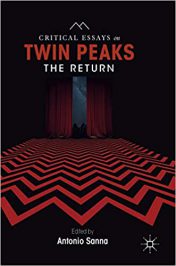Finally, while a huge fan community worldwide was hoping for more than two decades for a continuation of the tales of Agent Dale Copper in the Twin Peaks universe, in 2017 Showtime aired the series‘ third season. Twin Peaks The Return, with all episodes co-written by Mark Frost and David Lynch, did not disappoint the audiences.
This time, all episodes were directed by Lynch (in contrast: only six episodes of the original two seasons were created by him). He also directed the prequel movie Fire Walk With Me, that was presented at the Cannes Film Festival in 1992 (after the series was canceled by ABC in June 1991).
 The mass of texts, theories and possible plots continuations that were developed (and published) after 1991 by the fan community is only rivaled by the number of academic texts on the subject, as the Twin Peaks universe provides ideal data for sociologists, students of film theory, psychologists, and scholars of many other disciplines.
The mass of texts, theories and possible plots continuations that were developed (and published) after 1991 by the fan community is only rivaled by the number of academic texts on the subject, as the Twin Peaks universe provides ideal data for sociologists, students of film theory, psychologists, and scholars of many other disciplines.
As season two left audiences with many riddles and loose ends, most prominently (good) Agent Cooper incarcerated in the Black Lodge, while unbeknownst to everybody else, (bad) Agent Cooper was released in this world. Season three’s cast included almost all characters from the 1990s, while several new individuals – with the usual Lynchean secret double lives – were introduced.
And again, season three has a very special way of basically avoiding linear plot or rather, of introducing many non-linear episodes that make a highly complicated and cryptic story even harder to uncover: however, Twin Peaks audiences halfway knew what to expect.
The volume Critical Essays on Twin Peaks: The Return is the first publication that investigates the tactics, style, extra surrealistic environment of season three of the series that changed TV forever when it premiered in 1990.
Altogether, 18 authors present their speculations, findings and theories of what “really” happened in the third season. Loosely subdivided into three sections, the first one examines how the Twin Peaks universe and reality collide, while the next part deals with the supernatural and surreal elements of both worlds while the texts of the final section ponder traumatic and nightmarish experiences of the series’ characters. So topics such as a possible alien contact and influence and control of Earth history, Twin Peaks Fandom, nostalgia, Mark Frost’s Twin Peaks books, triplicity and otherness, transformation processes, the series’ altered concept of time, Kafkaesque crimes, digital technologies are researched. A number of texts enlarge on the role of sound and music, as in this season several contemporary bands provide diegetic music (mostly proving retro style in entire songs) for scenes at the Roadhouse.
And interpretation and decoding naturally will continue, as editor Antonio Sanna expects: “The scripts, contents, images and intertextuality of the series have been (re-) interpreted, fragmented, categorized, and deconstructed for over 25 years, as the plethora of publications from the time of the program’s airing to the present day has not managed to cover all the possible interpretations of the program and the film’s challenging and contradictory messages.”
For all audiences that watched season three, this book may be able to answer a few questions. But, as was to be expected, many others will remain unanswered, as Lynch drove both the story and plot of the season into a mysterious and bizarre amalgamation of nightmarish, brutal, strange and unreal stage.
And most fans will love that. (However, another season is not altogether impossible and would definitely be appreciated by the international fan community). Season three also features some extremely impressive cinematic art scenes and developments, some that frankly advertise their origins in German expressionism; episode 8 “White Light White Heat” is probably one of the most brilliant pieces of film that was ever shot for TV. This feature is as well commented on in the volume here.
Review by Dr. A. Ebert © 2019
Antonio Sanna. Critical Essays on Twin Peaks: The Return. Palgrave Macmillan, 2019, 302 p.
